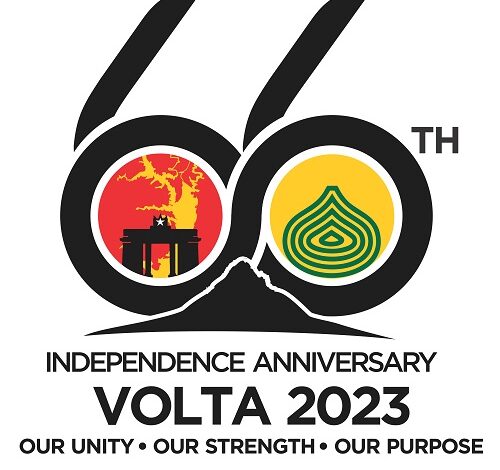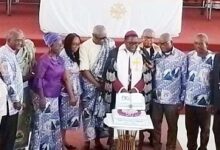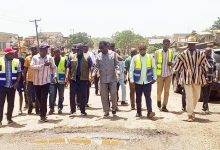
A Logo is a visually appealing mark, emblem, or symbol used to support and encourage public recognition and identification. It could have an abstract or figurative design, or a wordmark with the text of the name it stands for.
When incorporated into Independence Day celebrations and other significant events, it create a sense of unity and pride, communicate essential values and messages, and generate excitement and anticipation.
That is why since the celebration if independence day, logos have ben integral part of the celebration. This year’s Independence Day logo is inspired by the uniqueness of the Volta Region, the host region.
It bears contains the number 66, the map of the Volta Region, two interlocked circles, the mountain Afadjato, the Sabala symbol and the independence arch.
INTERLOCKED CIRCLE
The two circles seen in the 66 of the logo, symbolise wholeness and perfection and the combination in the logo indicates the unity of Ghanaians.
VOLTA RIVER
The Volta River is one of the major pride of the Volta Region. It is the largest river in Ghana, and one of the most important rivers in West Africa. The river flows from Burkina Faso through Ghana and empties into the Gulf of Guinea in the Atlantic Ocean.
Approximately 1,560 kilometres (970 miles) long with a drainage basin of about 400,000 square kilometres (150,000 square miles), the river is fed by several tributaries, including the Black Volta, White Volta, and Oti rivers.
It is an important source of water for irrigation, hydroelectric power generation, and transportation as it has since the 1960s, anchored the Akosombo Dam, the largest hydroelectric power generation facility in Ghana which provides about 70 per cent of the country’s electricity needs.
The river also plays an important role in Ghana’s tourism industry. It is home to several popular tourist attractions, such as Dodi Island, the Wli Waterfalls, and the Tagbo Falls which are popular destination for water sports, including fishing, boating, and kayaking.
Recognising that a river symbolizes life and the passage of time and therefore its inclusion in the logo indicates how the river has served the entire country since the country’s independence.
MOUNTAIN AFADJA
This is represented by an abstract silhouette on which figure ’66’ sits.
Mount Afadja is the highest mountain in Ghana, located in the Volta Region near the border with Togo. It has an elevation of about 885 meters (2,904 feet) above sea level and is part of the Agumatsa Range.
Mount Afadja is a popular destination for hikers and outdoor enthusiasts, offering stunning views of the surrounding landscape and a challenging but rewarding hiking experience. The mountain is covered with lush tropical forests and is home to a variety of wildlife, including monkeys, birds, and butterflies.
The hike to the summit of Afadjato takes about two hours and requires a moderate level of fitness. Along the way, hikers can enjoy panoramic views of the Volta Region and the nearby Togo Mountains in addition to outdoor activities, including birdwatching, camping, and exploring nearby waterfalls and rivers.
Overall, Afadjato is a unique and beautiful natural attraction in Ghana, offering a glimpse into the country’s diverse geography and rich natural heritage. It is a must-visit destination for nature lovers and outdoor enthusiasts visiting Ghana.
Making the entire logo sit on Mount Afadja tells that this year’s Independence Celebration rests on the solid foundations of the Volta land, thus VOLTA 2023.
SABALA SYMBOL
Onion-shaped adinkra symbol, Sabala, represents co-existence and tolerance; Unity in diversity. That gives us the strength to achieve our purpose. Although Ewes are spread over the globe, they maintain their Ewes identity while actively attempting to live in peace and harmony with individuals from various cultural backgrounds.
THE INDEPENDENCE ARCH
This is a monument that symbolises Ghana’s Independence
The Independence Arch, also known as the Black Star Gate, is an iconic monument located in Accra, the capital city of Ghana. The arch commemorated Ghana’s independence from British colonial rule on March 6, 1957.
The arch was designed by Ghanaian architect, Theo Akatugba, and was constructed in 1961. The arch is made up of two towers that are connected at the top by a crossbeam and adorned with a black star, which is a symbol of African freedom and unity.
The arch is located on a busy thoroughfare in Accra and serves as a symbol of Ghana’s independence and sovereignty. It is also a popular destination for tourists and a site for national celebrations and events.
Today, the Ghana Independence Arch remains an important symbol of Ghana’s independence and its commitment to freedom and democracy. It is a proud reminder of Ghana’s rich history and culture and serves as a source of inspiration for Ghanaians and people around the world.
Commenting on the logo, the Deputy Director of Communications at the Office of the President and member of the planning committee of the celebration, Jefferson Kwamina Sackey, noted that the logo’s elements were influenced by the need to showcase the valuable contribution of the Volta Region to the Independence struggle.
“There have been significant individuals from the region that have contributed significantly to the development efforts of our country. We can talk about Phillip Gheho and the role the former president Jerry John Rawlings also played,” he explained.
He added that the volta region boasts beautiful tourist sites like the mountain Afadjato, Wli Waterfalls and Dodi island that needed to be seen by the people of Ghana and foreigners hence the choice for this year’s venue.
BY JESSEL LARTEY THERSON-COFIE



